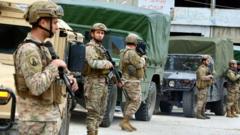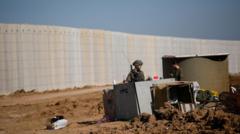The Israeli bombing campaign in Lebanon is raising alarms about the safety of ancient Roman structures in Baalbek and Tyre, with experts warning of irreversible harm as airstrikes get perilously close to these UNESCO-designated sites.
Ancient Ruins Under Siege: Israeli Strikes Threaten Baalbek and Tyre

Ancient Ruins Under Siege: Israeli Strikes Threaten Baalbek and Tyre
Recent airstrikes by Israel near Lebanon's ancient sites prompt concern from archaeologists regarding potential irreparable damage to cultural heritage.
In a troubling escalation of conflict, recent Israeli airstrikes near Baalbek's iconic Roman ruins have ignited fears among archaeologists and cultural heritage advocates. This past Wednesday, a vehicle park merely meters from the UNESCO World Heritage site was struck, along with a century-old Ottoman structure, raising concerns about the sensitive status of Lebanon's archaeological treasures. Renowned archaeology professor Graham Philip from Durham University emphasized the significance of Baalbek, declaring, "You couldn't replace it if someone bombed it. It would be a huge loss. It would be a crime."
Since September, Israeli forces have launched thousands of air raids across Lebanon, targeting the Iran-backed group Hezbollah. While the Israel Defense Forces (IDF) claim they focus solely on military targets, many of these locations are alarmingly close to historic ruins, with videos capturing plumes of smoke rising perilously near the ancient sites of Baalbek and Tyre. The Temple of Bacchus at Baalbek, revered as a pinnacle of Imperial Roman architecture, is particularly at risk, according to local archaeologist Joanne Farchakh Bajjaly.
Despite there being no confirmed damage to the ruins yet, the vicinity of military actions to these ancient structures has prompted UNESCO and local experts to voice deep concerns. "Baalbek is within the targeted area, and there are no Hezbollah facilities there," Bajjaly asserts, questioning the rationale behind the strikes.
In a statement, the IDF assured the public that the targeting of sensitive sites like Baalbek is incorporated into their military planning. The Israeli government had earlier issued evacuation orders for areas surrounding the Roman ruins. As tensions escalate, some locals, believing the ancient sites would remain untouched, have sought sanctuary in Baalbek, leading to warnings from authorities regarding the risks involved.
Archaeologists like Erez Ben-Yosef have acknowledged the complexity of the situation, highlighting the delicate balance between military objectives and the preservation of cultural heritage. Philip expressed his concerns that unintentional collateral damage remains a significant risk with ongoing bombardments.
As the situation continues to evolve, the impact of the conflict on Lebanon's rich historical landscapes remains uncertain. Parallel efforts are underway to document similar damage in Gaza, where past violence has already taken a toll on numerous cultural heritage sites. Ultimately, the ongoing strife underscores the pressing need to safeguard irreplaceable fragments of history that connect future generations to their cultural roots.




















